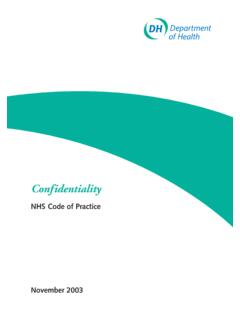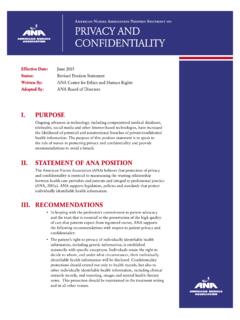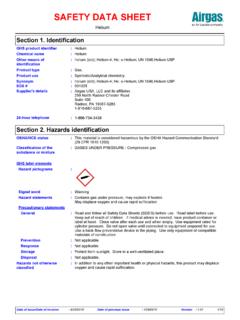Transcription of Data Elements in Electronic Health Records (EHRs)
1 Improving Health -Care Statistics Through Electronic Medical Records and Health Information Exchange National Center for Health Statistics, Centers for Disease Control and Prevention SUMMARY. Goals: Explore the potential for Electronic medical Records EMRs to enhance the nation's Health - care statistics capabilities, and Identify ideas for further development and research Vision for EMRs and Where We Are in Realizing That Vision Presenter: Karen Bell, Office of the National Coordinator for Health Information Technology Office of the Secretary, Department of Health and Human Services. Vision A patient-centric system with Health information technology (HIT) available anywhere, at any time in a secure and confidential manner and will include virtual care. The achievement of this vision will: Streamline administrative costs Permit comparison of quality of care across providers Maximize Health and medical information in a way that optimizes patient treatment Promotes preventive services such as cancer screenings How to get there The federal government has the following tools at its disposal: Laws and regulations Purchasing clout, conditions of doing business Payment policy and incentives Influence/leadership Other relevant issues Privacy, security, medical legal issues, culture change, workforce Electronic Health Records (EHR) what do we actually mean?
2 Possible meanings: Physicians within a specific system have access to an EHR, patients have access to EHR or to Electronic EHI for their entire medical histories Value of HIT need to standardize ways to measure its value 1. The HealthCare Statistics Enterprise and Requirements for Successful Statistics Presenter: Catharine Burt, National Center for Health Statistics, Centers for Disease Control and Prevention Major Considerations What data Elements are in EMRs? What is the extent of penetration of EMRs Who controls the data and how can we get access to it? What are the quality and consistency of data ? What benefits may arise from using EMR data statistically? What privacy and confidentiality issues must be considered? HIT adoption NCHS began tracking HIT adoption in ambulatory care settings in 2001. The original goal was to determine when adoption would be so common that our data collection systems would have to respond to it.
3 Messaging standards NCHS conducted a transmission study for the Emergency Department component of the National Hospital Ambulatory Medical Care Survey (NHAMCS-ED). The goal of the study was to determine which data Elements in the survey were covered by messaging standards to ensure their interoperability. The ASC X12 837 Health Care Service data Reporting Guide (HCSDRG) was used as a standard. The HCSDRG had similar or identical standards to the NHAMCS ED for patient demographics, diagnosis codes, e-codes, and expected source of payment. No messaging standards were available for most clinical variables collected on NHAMCS-ED. Some potentially valuable data such as charge data has messaging standards, although these data are not currently collected on NHAMCS. EMR data quality Analysis of data from hospitals using and not using EMRs found that item non-response was similar for the different types of hospitals, but many questions remain unanswered about data quality.
4 Do EMR's offer possibilities for improved data collection? For our surveys which sample individual physician encounters, the opportunity exists to get information beyond that encounter including clinical, financial, and provider data , as well as linkages to other data sources. Privacy and confidentiality are also obviously important. 1. data Elements in Electronic Health Records (EHRs). Presenter and discussion leader: Paul Tang, Palo Alto Medical Foundation and American Medical Informatics Association Presentation summary For clinicians, the goal of using an EHR is to deliver high quality care. Use of data for other purposes ( , quality improvement, population reporting, clinical research) should be a by-product of its use in the care process. To produce data that can be used appropriately for Health statistics, it is suggested that we re-focus on the population Health questions that need to be answered first, then ascertain what data are needed to answer these questions and how best to capture these data in EHRs.
5 EHRs have data in a variety of domains that are standardized, but because not all the code sets are complete, use of local enhancements to the code sets prevents full interoperability among EHR. systems without manual intervention ( , mapping of non-standard codes). For example, ICD-9- CM diagnosis codes do not include important clinical classifications of asthma that affect treatment decisions. On the other hand, ICD-10-CM does include the required codes for asthma. There are many clinical situations, such as patient refusal of a recommended treatment, that do not have standard codes. Consequently, the providers use dummy codes which results in a lack of standardization. In addition, physicians may want to document information that is more specific than a given coding scheme allows. For example, they may wish to code drug allergies to specific ingredients rather than just the chemical class. Next steps Re-examine Health statistics priorities to see if there are priorities that have not been implemented due to lack of accessible data that could now be served using EHR data Develop clinical measures that reflect population- Health priorities Identify critical data Elements for the desired measures Identify data gaps in critical Elements Get data through EHRs as part of user workflow.
6 Discussion Re-examine Health statistics priorities: The feasibility of using EHR data to assess population Health and overall patient Health was discussed. One related limitation is the lack of outcome data . Kaiser has made some progress in this area and envisions more in the future. Whether or not Health care statistics priorities should be re-examined was questioned, as there are already federal processes in place to establish these priorities. Quality of coding: Potential opportunities to improve upon coding include use of the National Library of Medicine's RxNorm system for medications. Reinforcement of good coding: Reinforcing good coding behavior by reusing data to improve user workflow improves accuracy and completeness of coding. Because of interoperability limitations, EHRs rarely contain data across the continuum of care, but these data are important both to patient care and to obtaining population Health statistics.
7 1. Accessing EMR data : Where the data reside and how federal agencies could arrange access Presenter and discussion leader: Linda Kloss, American Health Information Management Association Presentation summary data from medical Records are reported to many different federal and non-federal sources. Medical Records data are put to many uses, fill many needs, and requirements from both public and private entities including for payment purposes and assessing Health care quality. There are numerous reporting requirements and measurement systems. They are not consistent or coordinated with each other. To assess quality, bridging silos across patient settings is important. Trusted aggregators of data can pull data together across sources and supply it for purposes of assessing quality and creating transparency, which is of interest to public and private payers and for public Health . These same data can be used for clinical research, policy research, and other types of performance evaluation.
8 A variety of activities are needed to produce Health care statistics including data collection and capture, standards for interoperability, data exchange, aggregation, and analyses by different users. State Health information exchange organizations take on the role of data capture and information exchange and sometimes data aggregation. Tools available to achieve these goals are: laws and regulations, purchasing clout, conditions of doing business, payment policy and incentives, and influence Discussion Health Information Exchange presents the opportunity to cross-settings to create patient centered data . The group affirmed the importance of having different types of data , including: patient- centered data , provider-centered data , cross-sectional data , and longitudinal data , limited standardized datasets that cover all patients, and more detailed data sets obtained from representative samples. The complementary nature of these data sources was discussed.
9 Trusted aggregators' face legal barriers related to privacy and confidentiality that limit sharing with others, including the providers who contribute the data in the first place. Factors that influence completeness and accuracy of data include the quality of the original documentation, the variability of performance measures and payer reporting, and availability of secondary databases at the state or local levels. data tend to be provider centric because the data are owned by providers. The proprietary interests and profit-motives of organizations that own data cannot be ignored. The market is changing rapidly. A set of requirements is needed to lay on top of the market, to see how the market responds. Efforts to identify quality measures are occurring on a broad number of fronts at once, both public and private. The American Health Information Community (AHIC) has a workgroup to create interoperability standards for Electronic quality measures.
10 1. Quality, completeness, accuracy, comprehensiveness, and timeliness of data Cost of converting data for use in Health -care statistics Presenter and discussion leader: Mark C. Hornbrook, The Center for Health Research, Kaiser Permanente Northwest Presentation summary Electronic medical record (EMR) data are becoming common for Health care delivery. EMR data are input by providers in the process of providing care. Health care statistics are derived from EMR data warehouses. The data requirements and idiosyncrasies for Health statistics differ from those for patient care. EMRs are a boon to researchers, but using data designed for patient care for research purposes is challenging. Access: Some businesses have adopted EMR systems for patient care but do not allow researchers access, while others allow access to varying amounts of EMR content. Accuracy and completeness: EMR data are like hard copy charts.
















